 |
 |
 |
| |
Evaluation of Viral Variants During a Phase 2 Study (PROVE2) of Telaprevir with Peg-interferon alfa-2a and Ribavirin in Treatment-naïve HCV Genotype 1-Infected Patients
|
| |
| |
Reported by Jules Levin
AASLD, Nov 2-6, 2007, Boston, MA
Tara Kieffer1, Doug Bartels1, Yi Zhou1, Eileen Zhang1, Michelle Marcial1, Tom Pfeiffer1, Randal Byrn1, Janice Miller1, Ann Tigges1, Ann Kwong1, Peter Ferenci2, Geoffrey Dusheiko3, Stefan Zeuzem4, Jean-Michel Pawlotsky5:
(1) Vertex Pharmaceuticals Incorporated, Cambridge MA 02139, USA. (2) Department of Internal Medicine III, Medical University of Vienna, Vienna, Austria. (3) Centre for Hepatology, Royal Free Hospital, London, UK. (4) Internal Medicine Clinic II, Saarland University Hospital, Homburg/Saar, Germany. (5) Department of Virology, Henri Mondor Hospital, University of Paris XII, Créteil, France.
Author Discussion
In subjects treated with TVR/Peg-IFN/RBV, viral breakthrough was seen in 2% of subjects and was associated with the selection of TVR-resistant variants.
-- RBV is important to increase antiviral efficacy and decrease the rate of break-through with TVR-resistant variants.
-- Telaprevir should be stopped upon detection of viral breakthrough.
In subjects treated with TVR/Peg-IFN/RBV, relapse was primarily associated with single substitutions that confer low-level resistance, indicating that duration of treatment is not associated with increasing levels of phenotypic resistance (as would be expected with continued viral evolution).
Evidence of initial response was observed in subjects with low-level telaprevir-resistant variants dominant at baseline.
TVR-resistant variants selected during treatment were subsequently replaced by WT virus in the absence of drug selective pressure in some subjects.
WT virus appears to be cleared after 8 weeks of TVR/Peg-IFN/RBV treatment. Low-level telaprevir-resistant variants appear to be cleared in many subjects after 12 weeks of TVR/Peg-IFN/RBV treatment.
Depending on treatment duration, the combination of TVR/Peg-IFN/RBV ap-pears able to suppress all WT and telaprevir-resistant variants in most patients.
ABSTRACT
Background: VX05-950-104EU (PROVE2) is a Phase 2 study of an HCV protease inhibitor, telaprevir (VX-950, TVR) 750 mg q8h, in combination with Peg-IFN-alfa-2a (P) 180 _g/week and ribavirin (R) 1000-1200 mg/day in treatment-naive subjects with genotype 1 hepatitis C. Subjects were randomized into 4 groups that received: A) P/R for 48 weeks (control group), B) TVR/P/R for 12 weeks followed by 12 weeks of P/R, C) TVR/P/R for 12 weeks, and D) TVR/P for 12 weeks. Viral breakthrough (increase of > 1-log above HCV RNA nadir or increase to > 100 IU/mL in previously undetectable patients) was observed in some sub-jects during the first 12 weeks of therapy. Viral sequencing was used to evaluate the contribution of TVR resistance to antiviral response.
Methods: Plasma samples for viral sequencing were taken at baseline and at each HCV RNA assessment. The NS3-4A RNA region was amplified by nested RT-PCR and sequenced in samples with HCV RNA > 1,000 IU/mL. Prospectively defined criteria for identifying potential resistance mutations were applied using a Poisson distribution.
Results:
HCV RNA was undetectable (LOD 10 IU/mL) at Week 4 in 13% of subjects in the P/R group, 70 and 81% in the TVR/P/R groups (24 and 12 weeks, respectively) (p<0.001), and 51% in the TVR/P group (p<0.001); and at Week 12 in 41% of subjects in the P/R group, 73 and 79% in the TVR/P/R groups (24 and 12 weeks, respectively) (p<0.001), and 61% in the TVR/P group (p<0.012).
During the first 12 weeks on treatment, 4 of 162 subjects (2%) in the TVR/P/R groups, 19 of 79 subjects in the TVR/P group (24%), and 1 of 82 subjects (1%) in the P/R group had viral breakthrough.
The breakthroughs were associated with wild-type virus in the P/R group and previously identified TVR-resistant variants in the TVR groups (TVR/P/R: genotype 1a, n=3: V36M and R155K; genotype 1b, n=1: A156T; TVR/P: genotype 1a, n=12: R155K and V36M+R155K; genotype 1b, n=7: mainly V36A, T54A, R155K, and A156S/T).
Conclusions: In this interim analysis, TVR/P/R produced a significantly greater antiviral response at Weeks 4 and 12 compared to TVR/P and P/R in treatment-naive subjects with genotype 1 HCV. In the TVR groups, viral breakthroughs were associated with the selection of known TVR-resistant variants. The breakthrough rate in the TVR/P group was higher than in the TVR/P/R groups, suggesting that suboptimal inhibition of viral replication provides a greater probability for selection of TVR-resistant variants. Some subjects with viral breakthrough on TVR had a subsequent decline in HCV RNA during treatment with P/R; these subjects are being followed for SVR.
INTRODUCTION
Telaprevir (VX-950, TVR) is a potent, highly selective inhibitor of the HCV NS3-4a protease. PROVE2 (VX05-950-104EU) is a Phase 2 study of telaprevir 750 mg q8h, in combination with Peg-IFN-alfa-2a (Peg-IFN) 180 _g/week and ribavirin (RBV) 1000-1200 mg/day in treatment-naive subjects with genotype 1 hepatitis C. Subjects were randomized into 4 groups:
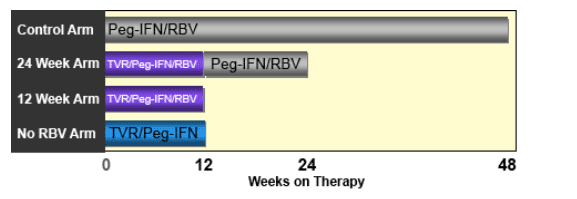
Viral sequencing was used to evaluate the contribution of TVR resistance to antiviral response in a subset of subjects with:
-- Viral breakthrough: increase of > 1-log above HCV RNA nadir or increase to >100 IU/mL during treatment in previously undetectable patients
-- Viral Relapse: becoming HCV RNA detectable post-dosing with TVR or Peg-IFN+RBV
METHODS
HCV RNA Levels
Plasma HCV RNA levels were measured using the Roche COBAS Taqman HCV/HPS assay. The lower limit of quantitation for the HCV RNA assay was 30 IU/mL and the limit of detection was 10 IU/mL.
Amplification and Sequencing of HCV from Subject Plasma
Blood samples were collected from subjects before, during, and after the study drug dosing period. Sequence analysis was done by nested RT-PCR amplification of an approximately 9 kb HCV RNA fragment spanning the HCV polyprotein coding region. The NS3 and NS4a regions were sequenced from the purified DNA (Agencourt¨ Biosciences, Beverly MA). The lower limit of detection (LOD) for the sequencing assay was 1000 IU/mL.
Sequence Alignment and Analysis
Sequences were aligned and analyzed for substitutions using the software Mutational Surveyor (SoftGe-netics, State College, PA). Prospectively-defined criteria for identifying potential resistance mutations were applied using a Poisson distribution with the threshold based on a Bonferroni correction:
(P (F given f, for N trials) = e^(-Nf) (Nf)^(NF) / (NF)!)
n: total number of sequences in public and Vertex baseline databases
N: number of patient sequences
f: expected frequency (upper bound = 1/n)
F: observed frequency
RESULTS
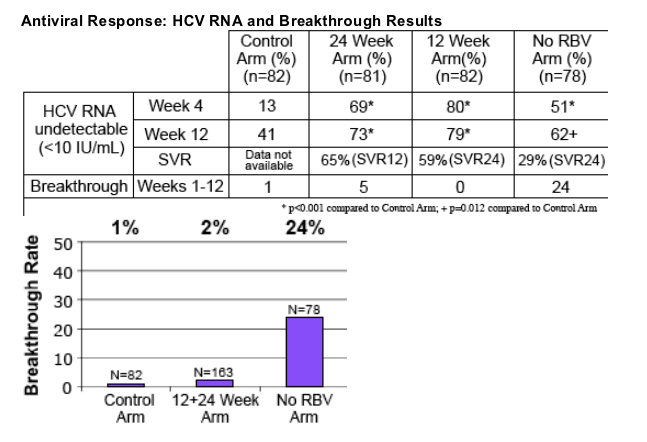
The breakthrough rate in the No RBV Arm was higher than in the 12 and 24 Week Arms, suggesting that the antiviral activity of RBV is important to decrease the probability for selecting TVR-resistant variants.
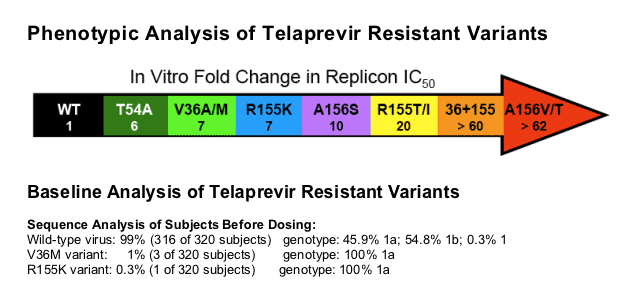
Evidence of initial response was observed in subjects with low-level telaprevir-resistant variants dominant baseline. Two subjects with V36M were dosed with TVR and achieved an SVR24.
*The remaining subject with V36M was in the control group.
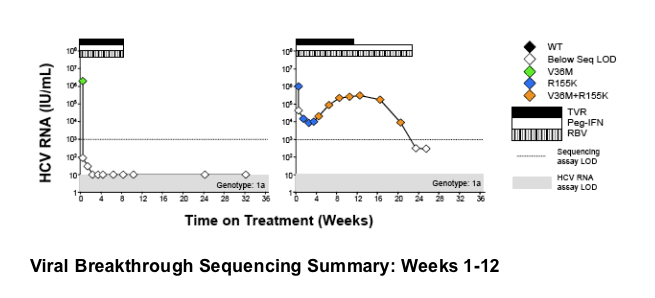
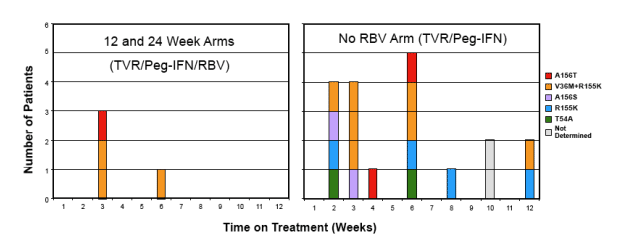
In 12 and 24 Week Arms, breakthrough:
--Rate is low (2%)
--Occurs early (3 of 4 in first 4 weeks)
--Occurs with higher-level resistant variants
--4 of 4 subjects never achieved undetectable levels of HCV RNA (<10 IU/mL)
In No RBV Arm, breakthrough:
--Rate is higher than TVR/Peg-IFN/RBV (24%)
--Occurs early (9 of 19 in first 4 weeks)
--Occurs with lower & higher-level resistantvariants
--16 of 19 subjects never achieved undetectable levels of HCV RNA (<10 IU/mL)
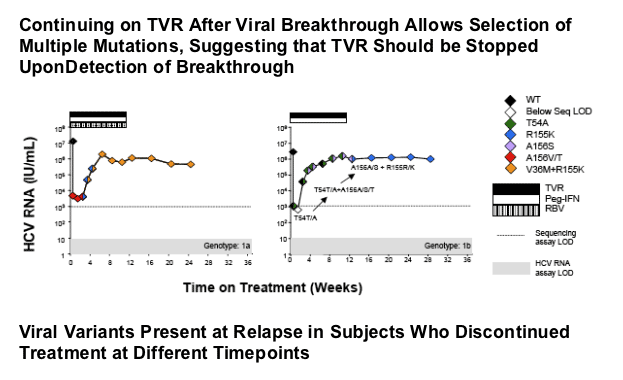
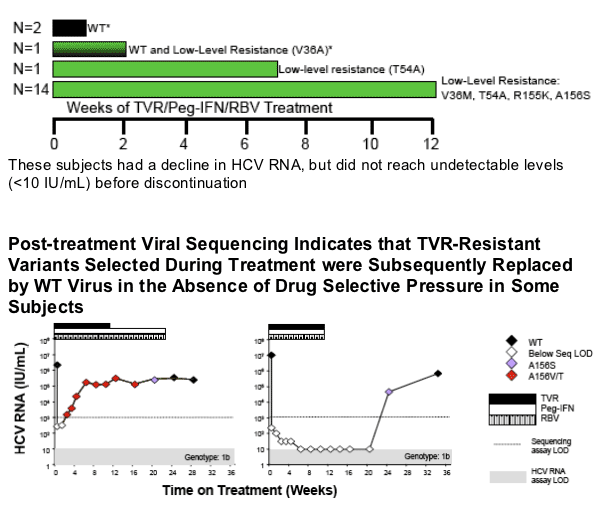
|
| |
|
 |
 |
|
|